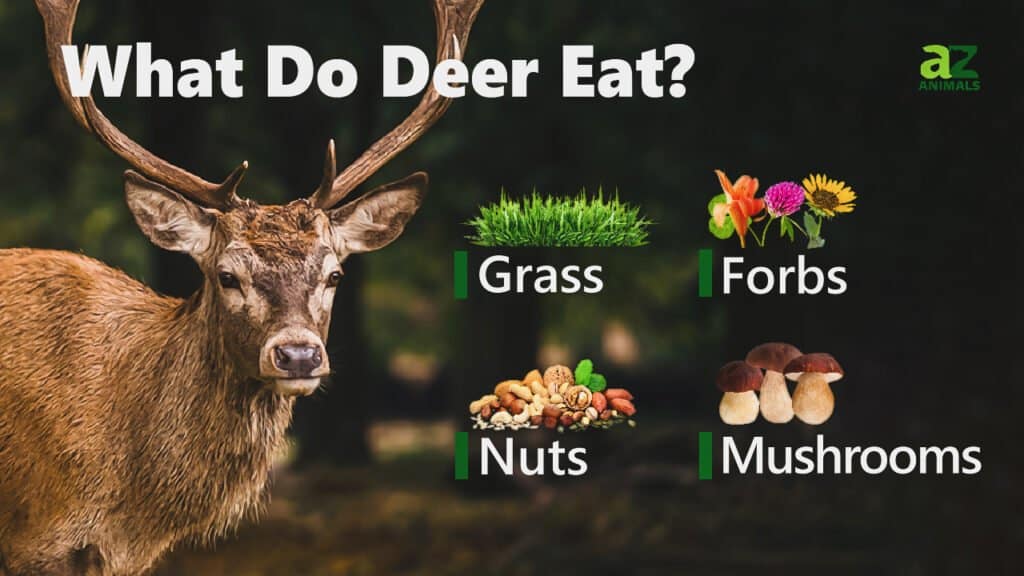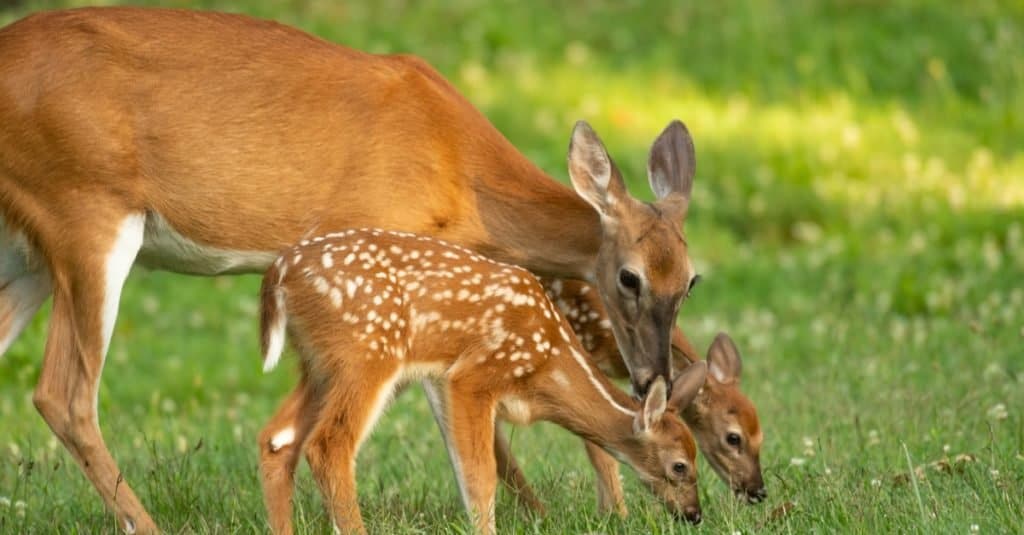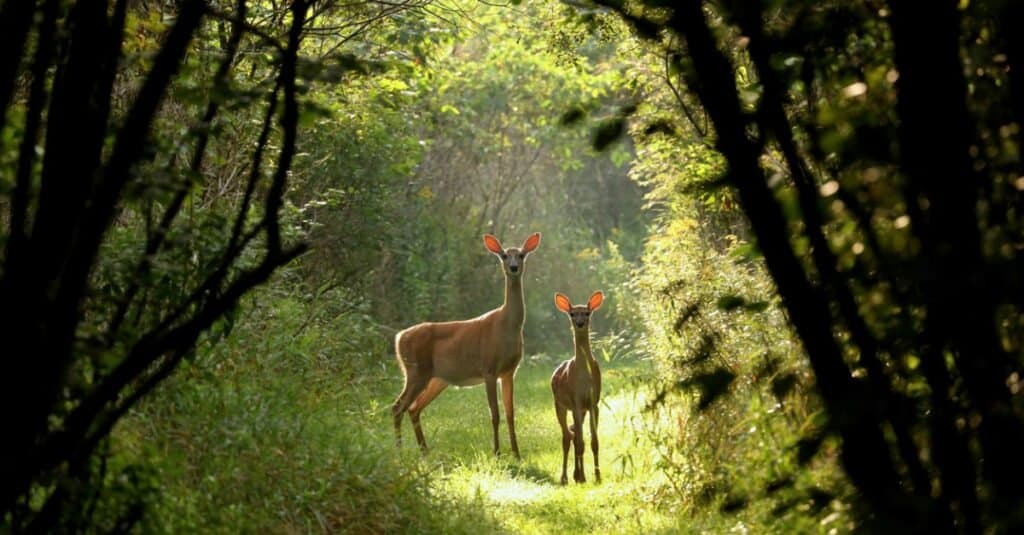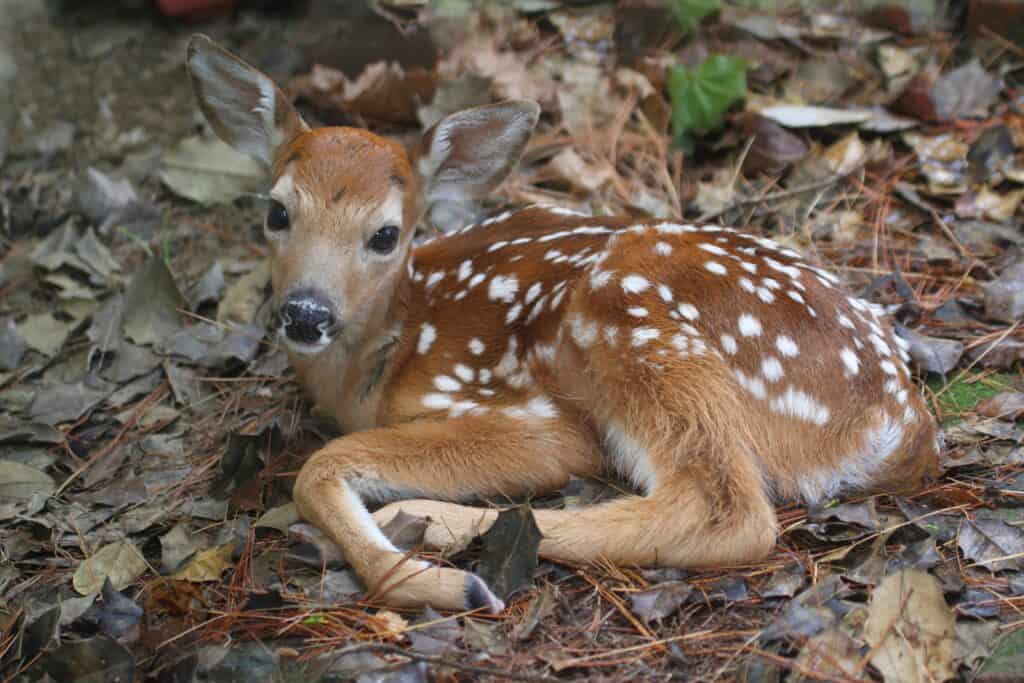White-tailed deer are the most common ungulate in the Americas. These mammals are known for their iconic whitetails, their varying sizes that increase the farther they live from the equator, and the high speeds they can reach while running. Like other wild deer, the white-tailed deer is herbivorous, feeding on a variety of plants, grasses, vegetation, acorns, and nuts. What specific foods do white-tailed deer eat, though?
Discover the foods they frequently consume, how they find meals in adverse weather, and what animals try to make a meal of them!
What Foods Do White-Tailed Deer Eat?

White-tailed deer eat grasses, legumes, leaves, and forbs. They are herbivorous creatures that spend much of their time foraging. They are especially active at night so they can avoid predators while they search for meals.
The most common foods that white-tailed deer eat are:
- Wild plum
- Prickly ash
- Seeds
- Ragweed
- Pokeweed
- Wild lettuce
- Wheat
- Wild strawberry
- Acorns
- Corn (is okay in small amounts, otherwise it can be deadly)
- Grapes
- Berries
- Chestnuts
- Apples
- Pears
- Ryegrass
- Oats
- Lichens
- Mushrooms
White-tailed deer have a wide variety of foods to eat when they are looking for a meal. They primarily eat grasses, leaves, and other easy-to-obtain foods, but they will consume a variety of foods throughout the year. Like other animals, they will focus on seeking other meals when their preferred fare becomes scarce.
White-tailed deer can eat various grasses and other hard-to-digest foods because they are ruminants. They will fill the first portion of their stomach until they are satisfied and then go somewhere safe to digest the meal. They will regurgitate their food, chew the cud more, and then swallow it for a final time.
What Do Baby White-Tailed Deer Eat?

White-tailed deer fawns drink milk from their mothers and start foraging after a month.
©Tony Campbell/Shutterstock.com
The majority of white-tailed deer fawns are born between April and July. After they are born, they will exclusively drink milk from their mother for the first month of their lives. During this time, the mother will exhibit an interesting and risky behavior: they leave their fawns behind while foraging.
The fawns will be left in areas with moderate to dense vegetation, hiding them from predators while the mother feeds and drinks to replenish her energy. This act exposes fawns to danger. People frequently believe the fawns have been abandoned and may move them, or predators will sometimes find an unguarded fawn and attack.
White-tailed deer fawns drink milk from their mothers for the first 8-10 weeks of their lives before being totally weaned. After the first month, they begin to take part in foraging trips, but they still drink milk. White-tailed deer often stay with their mother for the first year of their lives before departing.
How Do White-Tailed Deer Find Food?

White-tailed deer have a great sense of smell that helps them find food and avoid predators.
©iStock.com/Karel Bock
White-tailed deer do not have much trouble finding food in their natural habitats. Even during times when fruits, legumes, and grasses are scarce, they can still eat twigs, nuts, and other plants. Their diverse diet lends itself to a life that is rife with food.
Finding their food is not too difficult. Although deer tend to have a rather poor sense of vision compared with other animals, their sense of smell is highly acute. They can smell some of their favorite foods from far-off distances and determine if a food is edible just by taking a whiff of it.
Although deer are very good at finding food, they tend to have a voracious appetite. Given that they can eat up to four pounds of food per day, some areas with high deer population densities are in danger of running out of food for deer to consume, especially in the colder months.
What Do White-Tailed Deer Eat in the Winter?

White-tailed deer eat grass, twigs, corn, and nuts during winter.
©Volodymyr Burdiak/Shutterstock.com
In the winter, white-tailed deer will frequently leave their typical living areas and migrate several miles to “yarding” locations where foods are more plentiful and shelter from the cold weather is available. During this time, the deer will congregate into large flocks, and it is not unusual to see several dozen white-tailed deer living and traveling together.
The reasons for this behavior are numerous, including helping them locate food and staying safe from predators by massing in groups that will make an attacker think twice about making a move.
Throughout the winter, white-tailed deer will eat:
- Grass
- Twigs
- Nuts
- Mushrooms
- Root bulbs
- Legumes
Their diet does not vary so much in the winter, but the availability of some of their preferred foods and the way they find them can change.
White-tailed deer can often be found yarding in or around former cornfields, providing them with leftover corn and access to various roots and plant matter. These deer are not afraid to work for a meal, either. They will dig through snow and ice to get to grasses and other foods.
Fortunately, their metabolism slows in the winter, so they don’t need to consume as much food during this time of year.
What Predators Hunt White-Tailed Deer?

Jaguars have no trouble chasing down a deer.
©GoWildPhotography/Shutterstock.com
Unfortunately, the white-tailed deer is a very popular prey for many animals. The vast range of this deer throughout the world exposes it to many predators, as does its large population and quantity of meat.
The most common white-tailed deer predators are:
- Coyotes
- Wolves
- Bobcats
- Mountain lions
- Bears
- Humans
- Alligators
- Jaguars
- Bald eagles
- Golden eagles
- Wolverines
- Foxes
- Canada Lynx
The young and small white-tailed deer face the greatest threat of predation. Adult deer can reach sizes of 4 feet tall at the shoulder and weigh over 400 pounds, so they’re not always an easy meal. Although they lack many defensive capabilities, they can deliver a powerful kick to enemies.
Furthermore, these deer can run at speeds of 30 mph for short distances, leap over 30 feet, and are great swimmers. A healthy adult can simply outrun many predators, but packs of predators mitigate their speed.
Humans are also a major predator of white-tailed deer, hunting them regularly for sport and meat. This practice is not a bad thing, though. Deer overpopulation is a real problem that can devastate an ecosystem, and regular hunts reduce this issue.
White-tailed deer are graceful herbivores that feed on a variety of plants, legumes, and other foods. They are widely distributed around the Americas and remain a common sight for many people. In fact, the population of white-tailed deer is exploding as many of their predators have been hunted or driven out of their territories.
The future may require more drastic measures to help control their population to prevent ecological damage and starvation amongst the throngs of white-tailed deer.
Where Do White-Tailed Deer Live?

White-tailed deer live in Canada, the United States, Mexico, Bolivia, Peru, the Caribbean, and Europe.
©Steve Byland/Shutterstock.com
White-tailed deer can be found throughout the Americas, from southern Canada where their range extends from Cape Breton Island to south-central British Columbia. The United States’ northern neighbor is home to three out of the 16 subspecies of white dear in existence, with a population of about 82,000 – 130,000.
That number is spectacularly dwarfed by the US population which is approximately 35 -36 million. It is a rather spectacular comeback since these cervids were nearly hunted to extinction. The south especially seems to be a firm favorite of these ungulates with about 5.5 million living in Texas, 2 million in Michigan, and 1.75 million in Alabama and Mississippi.
White-tailed deer also live in Mexico and can be found as far south as Peru and Bolivia. They have also been introduced to a number of Caribbean islands, Jamaica included, and even Europe as well.
Bonus: Is it Good to Feed Wild Deer?

White-tailed deer are beautiful creatures that are fun to see when they visit your yard.
©Michael Tatman/Shutterstock.com
Coming upon deer in your own backyard is a thrilling experience and may lead you to consider leaving food for these charming creatures to entice them to return. While this is tempting – please resist the urge. There are plenty of reasons not to do it because ultimately, it can harm the deer. These reasons include:
- Word of your generosity will get out – causing unnaturally high deer densities
- So many deer in one place will attract coyotes
- Disease could spread among the deer
- The deer will get territorial and more aggressive toward each other – leading to fights and injuries
- Increases the likelihood of deer-vehicle collisions.
- Deer may lose their fear of humans and become habituated to the feed site
- They may become trapped in an inferior winter habitat
There are many more reasons not to engage in this practice. Whenever you encounter deer at your home just take a deep breath and be mindful of how special their rare visits can be. It will surely be one of those magical nature moments that you will always cherish.
Summary of What White-Tailed Deer Eat
Here’s a recap of the foods that white-tailed deer commonly consume:
| Number | Food |
|---|---|
| 1 | Wild plum |
| 2 | Prickly ash |
| 3 | Seeds |
| 4 | Ragweed |
| 5 | Pokeweed |
| 6 | Wild lettuce |
| 7 | Wheat |
| 8 | Wild strawberry |
| 9 | Acorns |
| 10 | Grapes |
| 11 | Berries |
| 12 | Chestnuts |
| 13 | Apples |
| 14 | Pears |
| 15 | Ryegrass |
| 16 | Oats |
| 17 | Lichens |
| 18 | Mushrooms |
| 19 | Corn (In small amounts, otherwise it can be deadly) |
| 20 | Grass (In winter) |
| 21 | Twigs (In winter) |
| 22 | Nuts (In winter) |
| 23 | Root bulbs (In winter) |
| 24 | Legumes (In winter) |
The photo featured at the top of this post is © iStock.com/Harry Collins
Thank you for reading! Have some feedback for us? Contact the AZ Animals editorial team.






